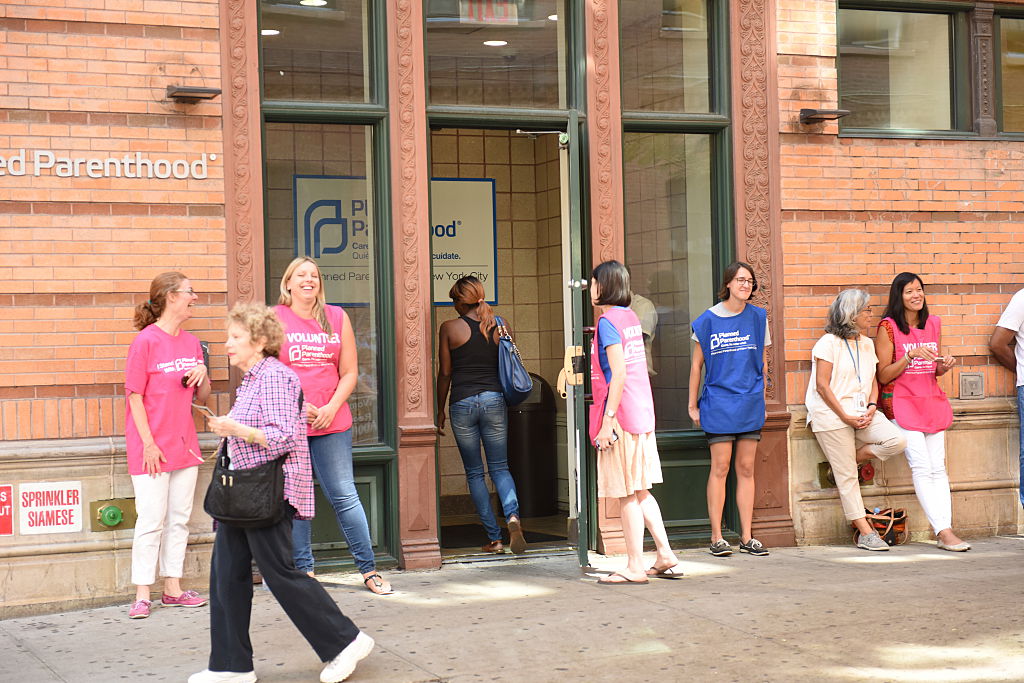It’s about a lot more than getting the patients into the building.
On the first morning I escorted, there was a man lingering by the entrance to the abortion clinic. I was supposed to meet another escort there, and she hadn’t arrived yet, so I waited by the door, while this man stood nearby. It was Saturday morning, 7.30, and the street was empty, except for this man, who was white and balding. (It’s not true that there’s never silence in New York City. It’s easier to find than you might think.) I am not, in general, a fan of being alone with strange men, so when he crossed the street, I felt relieved, but that soon disappeared when he returned to his original spot and started talking to me.
“I hope you’re not going to go in there,” he said. “They do abortions.” I ignored him, wondering if I should be scared, if I should try to go inside, if he was dangerous. He stared at me for a moment, and then went up the street. Later, I saw him in the crowd of kneeling, chanting protesters who gathered in front of the clinic with crosses and signs.
I’d paid mind to what I was wearing to escort, not just because of the weather. The goal is to be identifiable to patients, who may or may not seek you out on the walk from the car or the parking lot or the curb to the clinic, especially when they see the antis (it wasn’t totally uncommon for people to see the crowd of protesters and then leave.) The Clinic Vest Project sends vests that clearly delineate who the escorts are in a variety of languages (including ASL) to clinics in many states, including the one where I spent Saturdays in the Bronx. You need to also not be that identifiable to the antis, however, so our crew at the clinic refrained from wearing anything that might provide personal information about us, like a college sweatshirt. There were antis, like my man friend, who came week after week, and it had occurred to all of us that at some point, we might share a subway car or a grocery store line with any of them.
Here is the thing – it is not about the protesters, it’s about the patients. But it’s also about the protesters. It’s often said, and it’s true, that patients could be coming for an abortion, but they’re also possibly coming for a pap smear, or birth control, or a pregnancy test, or any other kind of reproductive health care offered. The antis aren’t there for pap smears, they’re there for the abortions, but I’m uncomfortable with the assertion that not every procedure that happens within the clinic is an abortion, because it should be okay if that’s the case. If you’ve ever wondered about the existence of abortion stigma, how deep and hard it runs, I suggest escorting. It will reveal itself, because it’s everywhere, even among escorts and providers. We’re not exempt. We all breathe the same air.
Escorting can be really boring. Sometimes, there are no antis, or there’s just one, and sometimes there are no patients, and you just stand there, outside, and wait out the shift. You notice things that you can’t notice when you’re busy trying to catch the eye of a girl and an older woman who look at the entrance to the clinic like they’re on fire and it is water, or when you’re putting your body between a woman yelling and waving a plastic fetus and a woman who’s late for her appointment. Like, why, in this neighborhood which is essentially all people of color, are all the providers and escorts white? Why do all the signs being held by the vastly black and brown crowd of antis have pictures of white children on them (including a white baby Jesus)?
Once, a church group pulled up at the back of the clinic in one of those tour buses that looked like it was for a rock band. Out of it came some blonde people who looked like parents and their children, and a young man, who turned out to be their pastor. They came all the way here to pray over the clinic, for the scores of dead babies, for the people having abortions who they imagined did not know any better, or who maybe did, and therefore needed Jesus even more. They stayed within the buffer zone – the area that antis are allowed to protest within, but not cross out of – and then they went around the front of the clinic. It was almost ten, soon the clinic would close and we could go home, but we followed them. They held each other’s hands, while the pastor, young and frankly handsome, recited a prayer. It sounded familiar, but I didn’t realize until I was mostly home that what he was doing was an exorcism. (I have seen a lot of horror movies.) We went inside in two shifts and hung up our vests, and when I came out, the group was descending into the subway, maybe heading to Times Square or the Statue of Liberty. They too had other things to do that day, apparently.
It is not about the antis, and it is. We would not have to be there if they were not, of course. Sometimes, it seems like a game of who can last longer in the cold or heat. I have left shifts with the Hail Mary running through my head, thinking how strange it is that this is how I learned it. It’s very easy to get wrapped up in this scene, to forget who it’s for, to feel like you won at the end of the morning, when in fact, you should always remember that you are literally holding a door for a moment, to make sure that someone can get into a place they should never have been kept out of.
Cover image courtesy of Getty Images




comments